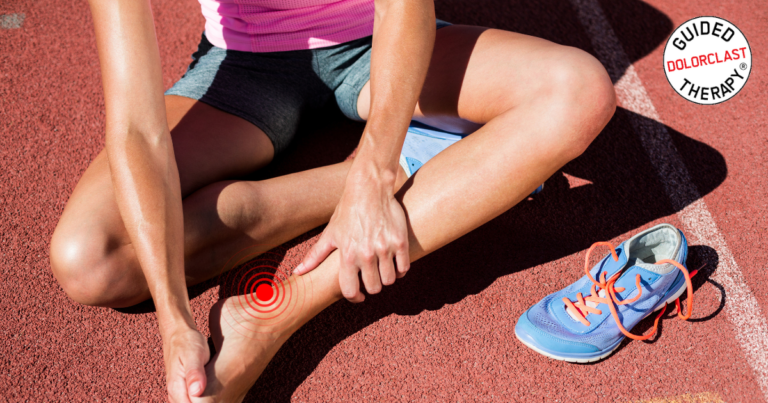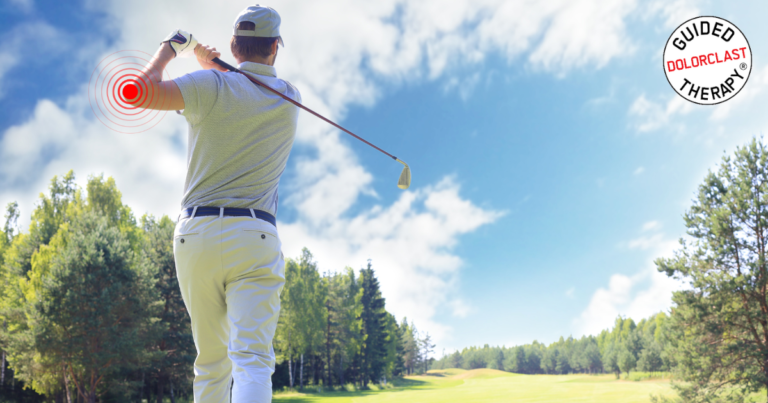Reference:
Gerdesmeyer L, Frey C, Vester J, et al.
"Radial extracorporeal shock wave therapy is safe and effective in the treatment of chronic recalcitrant plantar fasciitis: results of a confirmatory randomized placebo-controlled multicenter study"
Am J Sports Med 2008;36:2100-2109
RSWT® is a safe and effective method of treating greater trochanteric pain syndrome. DolorClast® Radial Shock Waves provided better results in a shorter time than home training.
This randomized controlled clinical trial study aimed to determine whether local corticosteroid injection, home training, and repetitive low-energy shock wave therapy provide outcomes of equal value four months from baseline.
Methods
Authors defined Great Trochanteric Pain Syndrome (GTPS) as chronic intermittent or continuous pain at and around the greater trochanter that can radiate to the hip or thigh's lateral aspect.
The study cohort consisted of three carefully selected groups of patients with refractory GTPS:
- Home training group (N=76) - patients performed five different slow, repetitive exercises (piriformis stretch, iliotibial band stretch standing, straight leg raise, wall squat with a ball, gluteal strengthening) twice a day, seven days a week, for 12 weeks;
- Corticosteroid injection group (N=75) - patients were treated with a single local corticosteroid injection (25 mg prednisolone);
- Shock Wave Therapy (SWT) group (N=78) - patients received Radial Shock Wave Therapy (RSWT®) in 3 weekly sessions without local anesthesia. 2000 pulses with a pressure of 3 bar (equal to an energy flux density of 0.12 mJ/mm2) were applied, and the treatment frequency was 8 pulses/s. Following the principle of clinical focusing, the authors treated the area of maximal tenderness in a circumferential pattern, beginning at the point of maximum pain level over the greater trochanter.
Patients did not differ clinically regarding baseline characteristics (all P>0.05). After six weeks, the patients were instructed to gradually return to their previous physical activities.
Radial extracorporeal shock waves were administered using DolorClast® Radial Shock Waves.
Outcomes
All patients underwent meticulous pretreatment evaluation. The clinical outcomes were determined by:
- level of recovery estimated with a 6-point Likert scale,
- level of pain during the past week measured with a numeric rating scale (NRS), where 0 is no pain and 10 is tantamount to the worst conceivable pain.
Results
At 1 month from baseline, the home training group demonstrated a 7% success rate and obtained 2.2 points on a numeric rating scale (NRS), the corticosteroid injection group 75% and 5.9 points, and shock wave therapy group 13% and 5.6 points. The therapeutic benefit of the corticosteroid injection group was not maintained.
At 4 months from baseline, home training had a 41% success rate and 5.2 points, corticosteroid injections 51% and 4.5 points, shock wave therapy 68% and 3.1 points.
The last follow-up at 15 months from baseline was a 48% success rate and 5.3 points for corticosteroid injection, 74% and 2.4 points for the shock wave therapy, and 80% and 2.7 points for the home training group.
Conclusion
This randomized controlled clinical trial has conclusively demonstrated that radial shock wave therapy provided significantly better results than corticosteroid injections and home training at 4 months from baseline. Furthermore, radial shock wave therapy allowed the quickest return to physical activities. At 4-months from baseline, as much as 64% of patients were able to return to their sports thanks to DolorClast® Radial Shock Waves. Only 34% and 49% of patients from other groups could return to previous physical activity levels. In the long term, radial shock wave therapy is superior to corticoid injections and demonstrated the best scores overall in terms of perceived pain after 15 months. The unique combination of radial shock wave therapy with a home training program is the gold standard for the treatment of GTPS.
DolorClast® Radial Shock Wave Therapy is a leader in the innovative and effective management of musculoskeletal conditions!
Full Study: http://www.ncbi.nlm.nih.gov/pubmed/19439758
Would you like to learn more about plantar fasciitis? Visit the indication page and discover how can you use Guided DolorClast® Therapy approach when treating patients!




